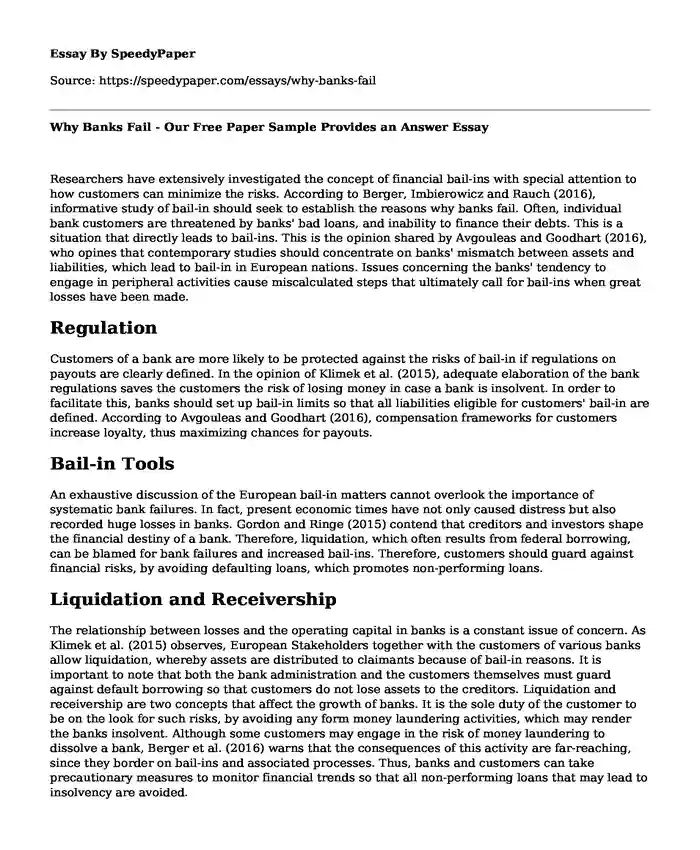Researchers have extensively investigated the concept of financial bail-ins with special attention to how customers can minimize the risks. According to Berger, Imbierowicz and Rauch (2016), informative study of bail-in should seek to establish the reasons why banks fail. Often, individual bank customers are threatened by banks' bad loans, and inability to finance their debts. This is a situation that directly leads to bail-ins. This is the opinion shared by Avgouleas and Goodhart (2016), who opines that contemporary studies should concentrate on banks' mismatch between assets and liabilities, which lead to bail-in in European nations. Issues concerning the banks' tendency to engage in peripheral activities cause miscalculated steps that ultimately call for bail-ins when great losses have been made.
Regulation
Customers of a bank are more likely to be protected against the risks of bail-in if regulations on payouts are clearly defined. In the opinion of Klimek et al. (2015), adequate elaboration of the bank regulations saves the customers the risk of losing money in case a bank is insolvent. In order to facilitate this, banks should set up bail-in limits so that all liabilities eligible for customers' bail-in are defined. According to Avgouleas and Goodhart (2016), compensation frameworks for customers increase loyalty, thus maximizing chances for payouts.
Bail-in Tools
An exhaustive discussion of the European bail-in matters cannot overlook the importance of systematic bank failures. In fact, present economic times have not only caused distress but also recorded huge losses in banks. Gordon and Ringe (2015) contend that creditors and investors shape the financial destiny of a bank. Therefore, liquidation, which often results from federal borrowing, can be blamed for bank failures and increased bail-ins. Therefore, customers should guard against financial risks, by avoiding defaulting loans, which promotes non-performing loans.
Liquidation and Receivership
The relationship between losses and the operating capital in banks is a constant issue of concern. As Klimek et al. (2015) observes, European Stakeholders together with the customers of various banks allow liquidation, whereby assets are distributed to claimants because of bail-in reasons. It is important to note that both the bank administration and the customers themselves must guard against default borrowing so that customers do not lose assets to the creditors. Liquidation and receivership are two concepts that affect the growth of banks. It is the sole duty of the customer to be on the look for such risks, by avoiding any form money laundering activities, which may render the banks insolvent. Although some customers may engage in the risk of money laundering to dissolve a bank, Berger et al. (2016) warns that the consequences of this activity are far-reaching, since they border on bail-ins and associated processes. Thus, banks and customers can take precautionary measures to monitor financial trends so that all non-performing loans that may lead to insolvency are avoided.
State Aid
Bank bail-ins in the European economy has been cited as a powerful strategy that enables a bank to make a comeback from within the premises. Various scholars agree that in instances where the customers are not able to bail-in the banks, state aid may be sought to save the insolvent state (Berger et al., 2016). Thus, state aid is required in instances where a bank has failed entirely to clear its debts. These concepts are useful in the investigation of bail-ins.
Reference List
Avgouleas, E & Goodhart, C 2016, 'An anatomy of bank bail-ins; Why the Eurozone needs a fiscal backstop for the banking sector,' European Economy, Available from http://european-economy.eu/2016-2/an-anatomy-of-bank-bail-ins-why-the-eurozone-needs-a-fiscal-backstop-for-the-banking-sector/. [9 March 2018].
Berger, A, Imbierowicz, B & Rauch, C 2016, 'The roles of corporate governance in bank failures during the recent financial crisis,' Journal of Money, Credit, and Banking, vol. 48, no. 4, pp.729-770.
Gordon, JN & Ringe, WG 2015, 'Bank resolution in the European Banking Union: A transatlantic perspective on what it would take,' Columbia Law Review, vol. 115, no. 5, pp.1297-1310.
Klimek, Peter, Sebastian Poledna, J. Doyne Farmer & Stefan Thurner 2015, 'To bail-out or to bail in? Answers from an agent-based model,' Journal of Economic Dynamics and Control, vol. 50, pp.144-154.
Cite this page
Why Banks Fail - Our Free Paper Sample Provides an Answer. (2022, Apr 04). Retrieved from https://speedypaper.com/essays/why-banks-fail
Request Removal
If you are the original author of this essay and no longer wish to have it published on the SpeedyPaper website, please click below to request its removal:
- Education Essay Sample: Academic Problems People Have Overcome
- Critical Thinking Essay Example: A Reflection on a Business Proposal
- Free Essay on Ethical Issues Surrounding Euthanasia
- Essay Sample: Hospitality Industry Placement
- Mandatory Public and Military Service. Paper Example
- Paper Example on Assistant Director Role Portfolio
- Analysis of Financial Misconduct - Paper Example
Popular categories





